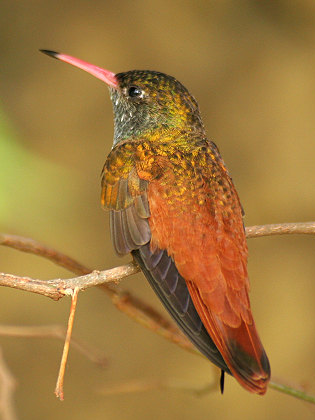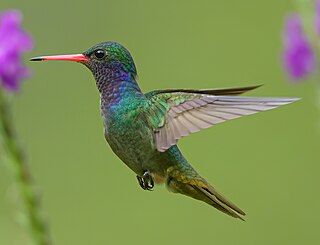
The copper-rumped hummingbird is a species of hummingbird in the "emeralds", tribe Trochilini of subfamily Trochilinae. It is found in Tobago, Trinidad, Venezuela, and possibly Grenada.

The rufous-tailed hummingbird is a medium-sized hummingbird in the "emeralds", tribe Trochilini of subfamily Trochilinae. It is found from east-central Mexico through Central America and Colombia into Ecuador and Venezuela.

The amazilia hummingbird is a hummingbird in the "emeralds", tribe Trochilini of subfamily Trochilinae. It is the only species placed in the genus Amazilis. It is found in Ecuador and Peru. Its six subspecies differ primarily in their throat and belly colors.

The buff-bellied hummingbird is a species of hummingbird in the "emeralds", tribe Trochilini of subfamily Trochilinae. It is found in Belize, Guatemala, Mexico, and the United States.

The pygmy three-toed sloth, also known as the monk sloth or dwarf sloth, is a species of sloth in the family Bradypodidae. The species is endemic to Isla Escudo de Veraguas, a small island off the Caribbean coast of Panama. The species was first described by Robert P. Anderson of the University of Kansas and Charles O. Handley Jr., of the Smithsonian Institution in 2001. The pygmy three-toed sloth is significantly smaller than the other three members of its genus, but otherwise resembles the brown-throated three-toed sloth. According to Anderson and Handley Jr., the head-and-body length is between 48 and 53 centimetres, and the body mass ranges from 2.5 to 3.5 kg.

Isla Escudo de Veraguas is a small (4.3 km2) isolated Caribbean island of the Republic of Panama. Despite its name, it is not part of the province of Veraguas, but rather Bocas del Toro. Although located only 17 km from the coastline in the Golfo de los Mosquitos and isolated for only about 9000 years, several animals found on the island are distinct from their mainland counterparts, and two mammal species or subspecies are recognized as occurring only on the island: the fruit bat Dermanura watsoni incomitata and the sloth Bradypus pygmaeus. These two taxa and the worm salamander Oedipina maritima are all considered to be critically endangered due to their being unique to the small island. Other mammals found on the island include the bats Glossophaga soricina, Micronycteris megalotis, Carollia brevicauda, Myotis riparius, and Saccopteryx leptura, the spiny rat Hoplomys gymnurus, and the opossum Caluromys derbianus. The island has 26.36 acres (10.67 ha) of mangrove forest and 247 acres (100 ha) of coral reef with 55 coral species. It houses over 11,000 species, such as the pygmy sloth. The island has an average high temperature of 23 degrees Celsius and a low temperature of 12 degrees Celsius.

Amazilia is a hummingbird genus in the subfamily Trochilinae. It is found in tropical Central and South America.

The white-bellied emerald is a species of hummingbird in the "emeralds", tribe Trochilini of subfamily Trochilinae. It is found in Belize, Guatemala, Honduras, Panamá, Mexico, and Nicaragua.

The blue-tailed hummingbird is a species of hummingbird in the "emeralds", tribe Trochilini of subfamily Trochilinae. It is found in Costa Rica, El Salvador, Guatemala, Honduras, Mexico, and Nicaragua.

The snowy-bellied hummingbird, also known as snowy-breasted hummingbird, is a species of hummingbird in the "emeralds", tribe Trochilini of subfamily Trochilinae. It is found in mostly in Costa Rica and Panama with a few records in Colombia.

The cinnamon hummingbird is a species of hummingbird in the "emeralds", tribe Trochilini of subfamily Trochilinae. It is found from northwestern Mexico to Costa Rica.

The blue-throated goldentail, also known as the blue-throated sapphire, is a species of hummingbird in the family Trochilidae. It is found in Belize, Colombia, Costa Rica, El Salvador, Guatemala, Honduras, Mexico, Nicaragua, and Panama. Its natural habitats are subtropical or tropical moist lowland forest and heavily degraded former forest.

The sapphire-throated hummingbird is a shiny metallic-green hummingbird found in Panama, Colombia, and more recently Costa Rica. The sapphire-throated hummingbird is separated into three subspecies; Chrysuronia coeruleogularis coeruleogularis, Chrysuronia coeruleogularis coelina, and Chrysuronia coeruleogularis conifis.

The rufous-crested coquette is a species of hummingbird native to the tropical slopes of pacific South America. Due to its small size and population, it is a rare sight even within its native region. Males of the species can be easily distinguished by their striking rufous coloured spiked crests, and females, while less obvious, can be identified by their small size and rufous coloured foreheads.

The glow-throated hummingbird is an Endangered species of hummingbird in tribe Mellisugini of subfamily Trochilinae, the "bee hummingbirds". It is endemic to a small area of Panama.
Oedipina maritima, commonly known as the maritime worm salamander, is a species of salamander in the family Plethodontidae. It is endemic to Isla Escudo de Veraguas, Panama.

The bay wren is a species of bird in the family Troglodytidae. It is native to southern Central America and northwestern South America.

The copper-tailed hummingbird is a species of hummingbird in the "emeralds", tribe Trochilini of subfamily Trochilinae. It is native to the tepuis of Venezuela and nearby areas of Brazil and Guyana ; it is a vagrant in French Guiana.

The pale-tailed canastero, is a species of bird in the Furnariinae subfamily of the ovenbird family Furnariidae. It is endemic to Peru.

















